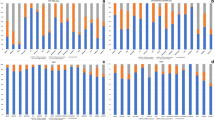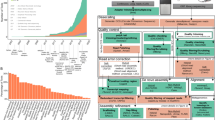Abstract
We sequenced the Paenibacillus sp. R4 using Oxford Nanopore Technology (ONT), single molecule real-time (SMRT) technology from Pacific Biosciences (PacBio), and Illumina technologies to investigate the application of nanopore reads in de novo sequencing of bacterial genomes. We compared the differences in both genome sequences between genome assemblies using nanopore and PacBio reads and focused on the difference in the prediction of coding sequences. The results indicated that for more accurate predictions of open reading frames, contigs in the assemblies using only PacBio reads also needed to be corrected using short reads with high-quality bases, and repeat regions in genomes did not affect the increase of mispredicted coding sequences via genome polishing significantly. In assemblies using only nanopore reads, genome polishing was essential, but many repeat regions in genomes might increase the number of mispredicted coding sequences via genome polishing. The hybrid assembly combining the long reads and short reads represents the best result for coding sequence predictions in genome assemblies using nanopore reads.




Similar content being viewed by others
Availability of data and material
The raw data have been deposited at the National Center for Biotechnology Information (NCBI) BioProject repository PRJNA564035 (SRX6807868-SRX6807870). This strain is available from the Polar and Alpine Microbial Collection (PAMC) of Korea Polar Research Institute with the accession number PAMC 29622.
References
Antipov D, Korobeynikov A, McLean JS, Pevzner PA (2016) HybridSPAdes: an algorithm for hybrid assembly of short and long reads. Bioinformatics 32:1009–1015
Ashton PM et al (2015) MinION nanopore sequencing identifies the position and structure of a bacterial antibiotic resistance island. Nat Biotechnol 33:296
Bolger AM, Lohse M, Usadel B (2014) Trimmomatic: a flexible trimmer for Illumina sequence data. Bioinformatics 30:2114–2120
Broder AZ (1997) On the resemblance and containment of documents. In: Proceedings. Compression and Complexity of SEQUENCES 1997 (Cat. No. 97TB100171). IEEE, pp 21–29
Chin C-S et al (2013) Nonhybrid, finished microbial genome assemblies from long-read SMRT sequencing data. Nat Methods 10:563
Clarke J, Wu H-C, Jayasinghe L, Patel A, Reid S, Bayley H (2009) Continuous base identification for single-molecule nanopore DNA sequencing. Nat Nanotechnol 4:265
De Maio N et al. (2019) Comparison of long-read sequencing technologies in the hybrid assembly of complex bacterial genomes. BioRxiv:530824
Delcher AL, Phillippy A, Carlton J, Salzberg SL (2002) Fast algorithms for large-scale genome alignment and comparison. Nucleic Acids Res 30:2478–2483
Deschamps S et al (2016) Characterization, correction and de novo assembly of an Oxford Nanopore genomic dataset from Agrobacterium tumefaciens. Sci Rep 6:28625
Eccles D, Chandler J, Camberis M, Henrissat B, Koren S, Le Gros G, Ewbank JJ (2018) De novo assembly of the complex genome of Nippostrongylus brasiliensis using MinION long reads. BMC Biol 16:6
Eid J et al (2009) Real-time DNA sequencing from single polymerase molecules. Science 323:133–138
Giordano F et al (2017) De novo yeast genome assemblies from MinION PacBio and MiSeq platforms. Sci Rep 7:3935
Goldstein S, Beka L, Graf J, Klassen JL (2019) Evaluation of strategies for the assembly of diverse bacterial genomes using MinION long-read sequencing. BMC Genomics 20:23
Hunt M, Kikuchi T, Sanders M, Newbold C, Berriman M, Otto TD (2013) REAPR: a universal tool for genome assembly evaluation. Genome Biol 14:R47
Jain M et al (2018) Nanopore sequencing and assembly of a human genome with ultra-long reads. Nat Biotechnol 36:338
Jain M, Olsen HE, Paten B, Akeson M (2016) The Oxford Nanopore MinION: delivery of nanopore sequencing to the genomics community. Genome Biol 17:239
Kim H, Park AK, Lee JH, Shin SC, Park H, Kim HW (2018) PsEst3, a new psychrophilic esterase from the Arctic bacterium Paenibacillus sp. R4: crystallization and X-ray crystallographic analysis. Acta Crystallogr F Struct Biol Commun 74:367–372. https://doi.org/10.1107/S2053230X18007525
Koren S, Walenz BP, Berlin K, Miller JR, Bergman NH, Phillippy AM (2017) Canu: scalable and accurate long-read assembly via adaptive k-mer weighting and repeat separation. Genome Res 27:722–736
Li H (2013) Aligning sequence reads, clone sequences and assembly contigs with BWA-MEM. arXiv preprint arXiv:13033997
Li H (2018) Minimap2: pairwise alignment for nucleotide sequences. Bioinformatics 34:3094–3100
Loman NJ, Quick J, Simpson JT (2015) A complete bacterial genome assembled de novo using only nanopore sequencing data. Nat Methods 12:733
Lu H, Giordano F, Ning Z (2016) Oxford Nanopore MinION sequencing and genome assembly. Genomics Proteomics Bioinformatics 14:265–279
Michael TP et al (2018) High contiguity Arabidopsis thaliana genome assembly with a single nanopore flow cell. Nat Commun 9:541
Parks DH, Imelfort M, Skennerton CT, Hugenholtz P, Tyson GW (2015) CheckM: assessing the quality of microbial genomes recovered from isolates, single cells, and metagenomes. Genome Res 25:1043–1055
Passera A, Marcolungo L, Casati P, Brasca M, Quaglino F, Cantaloni C, Delledonne M (2018) Hybrid genome assembly and annotation of Paenibacillus pasadenensis strain R16 reveals insights on endophytic life style and antifungal activity. PLoS ONE 13:e0189993
Ross MG et al (2013) Characterizing and measuring bias in sequence data. Genome Biol 14:R51
Schmidt MH-W et al (2017) De novo assembly of a new Solanum pennellii accession using nanopore sequencing. Plant Cell 29:2336–2348
seqtk. https://github.com/lh3/seqtk Accessed 26 Aug 2019
Shin SC et al (2019) Nanopore sequencing reads improve assembly and gene annotation of the Parochlus steinenii genome. Sci Rep 9:5095
Simão FA, Waterhouse RM, Ioannidis P, Kriventseva EV, Zdobnov EM (2015) BUSCO: assessing genome assembly and annotation completeness with single-copy orthologs. Bioinformatics 31(19):3210–3212
SMARTdenovo. https://github.com/ruanjue/smartdenovo. Accessed 19 Nov 2018
Tanizawa Y, Fujisawa T, Nakamura Y (2017) DFAST: a flexible prokaryotic genome annotation pipeline for faster genome publication. Bioinformatics 34:1037–1039
Tatusov RL, Galperin MY, Natale DA, Koonin EV (2000) The COG database: a tool for genome-scale analysis of protein functions and evolution. Nucleic Acids Res 28:33–36
Walker BJ et al (2014) Pilon: an integrated tool for comprehensive microbial variant detection and genome assembly improvement. PLoS ONE 9:e112963
Wick RR, Judd LM, Gorrie CL, Holt KE (2017) Unicycler: resolving bacterial genome assemblies from short and long sequencing reads. PLoS Comput Biol 13:e1005595
Funding
This research was supported by a National Research Foundation of Korea Grant from the Korean Government (MSIT; the Ministry of Science and ICT) (NRF-2017M1A5A1013568) (KOPRI-PN20082) (Title: application study on the Arctic cold-active enzyme degrading organic carbon compounds).
Author information
Authors and Affiliations
Contributions
Conceptualization: HWK, JHL, SCS; methodology: HJK, SCS; software: SCS; formal analysis: WC, SCS; investigation: WC; resources: SCS; data curation: SCS; writing—original draft preparation: All authors; writing—review and editing: All authors; visualization: SCS, HWK; supervision: SCS, HWK; project administration: SCS, HWK; funding: HWK.
Corresponding authors
Ethics declarations
Conflict of interest
The authors declare that they have no competing financial and non-financial interests.
Ethics approval
This article does not contain any studies with human participants or animals performed by any of the authors.
Electronic supplementary material
Below is the link to the electronic supplementary material.
Rights and permissions
About this article
Cite this article
Shin, S.C., Choi, W., Lee, J. et al. Evaluation of assembly methods combining long-reads and short-reads to obtain Paenibacillus sp. R4 high-quality complete genome. 3 Biotech 10, 480 (2020). https://doi.org/10.1007/s13205-020-02474-0
Received:
Accepted:
Published:
DOI: https://doi.org/10.1007/s13205-020-02474-0




